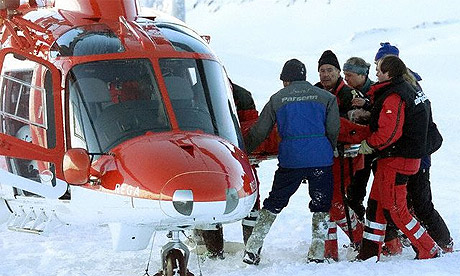Avalanche Slide Triggers Debate in Personal Responsibilty

A search and rescue has unintentionally lead to a debate on personal responsibility. The rescue occurred on Sunday May 25th and it was in response to trapped skiers who had inadvertently set off an avalanche. The Avalanche happened on the red mountains in the butte highlands and unbeknownst to the skiers they had entered a restricted area.
The rescue took 12 hours in total and involved 30 members of the rescue team, 2 helicopter crews, paramedics and police. It ended with 3 of the skiers being air lifted to safety. Only one was injured, Jack Preston and he was transported to hospital for suspected broken bones and diabetic emergency. Christina Hayden, Kevin and Amanda Curtis were unharmed. They were found in a large bowl area which is 8,000 feet and accessible only on foot. Helicopters witnessed 36 avalanche slides from the air and it is believed the skiers caused two more with one being responsible for trapping them in.
They had set off at 9 that morning and it was on their way down that the first avalanche happened. Once they realised Preston was unable to hike down they contacted search and rescue. The conditions made it impossible for them to be rescued by foot. “It was just bizarre conditions up there. You had hundreds of yards of dry dirt and then feet of the soupiest stuff,” Belke said. “You have to drag the ATVs across the snow just to get to the dirt. These guys were exhausted. We’d still be there if we had to carry these people out,”
Their first attempt at helicopter rescue failed as it was a medical transport helicopter which wasn\’t designed for snowy mountain rescue. So the next step was to bring in one from the Air force base with night vision technology. Meanwhile the skiers kept in constant contact by cell phone with the rescue crew and Christina Hayden had hiked down the mountain and had reached their staging area. Eventually the other three were rescued and brought to safety.
However Search and Rescue Commander Brad Belke felt the entire episode could have been easily avoided, had the skiers not entered the off limits area. He said “ The area is clearly marked on maps as restricted and conditions were ripe for avalanches. It makes me angry. We didn\’t get home until 4 am.” In response the skiers said “There were no signs saying the area was closed. Between the four of us, we have 60 years of combined experience skiing in the backcountry, We’ve skied that spot for 15 years.\”
But they were also incredible appreciative to the rescuers for all that they had done and proved this by turning up at their meeting two days later to thank them all in person. \”They were so helpful,\” said skier Amanda Curtis. \”And so good about communicating with us so that we knew that we were not left out there all alone, and that people were trying to get to us at every second.\” She explained that they had taken precautions that day \”We dug a pit and all four of us unanimously agreed that the conditions were safe,\”
She had been watching her husband as they desended the mountain when, \”I saw some snow slough off him, which is normal,\” she explained. \”But also saw that slough turn to waves like water, and so I yelled as loud as I could.\” It wasn\’t until after they had been rescued that they discovered the area was strictly off limits. Brad Belke acknowledges “they certainly weren\’t trying to do anything illegal, they were just recreating.\” and that he\’d heard of other people making the same mistake but \”The map is what the Forest Service goes by, and that\’s what the federal authorities go by. You have the responsibility of looking at that map,\” he said.\”I really feel that information about it being a restricted area was really hard to access, and that\’s not an excuse for us being in a restricted area, but I would not have gone there if I would have had that information,\” she said.
The ill fated trip has brought up much discussion about knowing where restricted areas are. NBC Montana met with Forest Service to discuss the confusion over the area. Forest Service explained the region had been closed for 6 years but was only marked on maps last year. There are no signs marking the area because people have been known to destroy them and the terrain is too rocky. \”If anyone had any questions about these closures whatsoever, they can come to the Forest Service, they can give us a call, they can come to the office and we can show them on a map. The new maps last year in 2013. And they can even purchase one of these maps, as well,\” said District Ranger Dave Sabo. Forest Services also recommend that people check every season for changes in restrictive areas.
You might also like
For relevant updates on Emergency Services news and events, subscribe to EmergencyServices.ie









